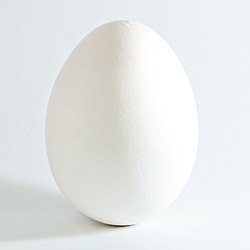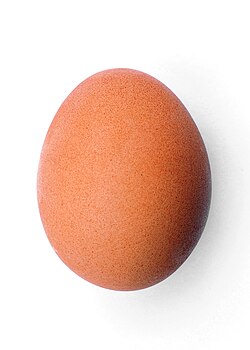Eggshell
This article needs additional citations for verification. (February 2008) |


An eggshell is the outer covering of a hard-shelled egg and of some forms of eggs with soft outer coats.
The generalized eggshell structure, which varies widely among species, is a protein matrix lined with mineral crystals, usually of a calcium compound such as calcium carbonate. It is calcium build-up and is not made of cells. Harder eggs are more mineralized than softer eggs.
Diversity

Insect eggs
Insects and other arthropods lay a variety of styles and shapes of eggs. Some have gelatinous or skin-like coverings, others have hard eggshells. Softer shells are mostly protein. It may be fibrous or quite liquid. Some arthropod eggs do not actually have shells, rather, their outer covering is actually the worlds outermost embryonic membrane, the choroid, which serves to protect inner layers. The choroid itself can be a complex structure, and it may have different layers within it. It may have an outermost layer called an exochorion. Eggs which must survive in dry conditions usually have hard eggshells, made mostly of dehydrated or mineralized proteins with pore systems to allow respiration. Arthropod eggs can have extensive ornamentation on their outer surfaces.
Fish, amphibian and reptile eggs
Fish and amphibians generally lay eggs which are surrounded by the extraembryonic membranes but do not develop a shell, hard or soft, around these membranes. Some fish and amphibian eggs have thick, leathery coats, especially if they must withstand physical force or desiccation. These type of eggs can also be very small and fragile.
While many reptiles lay eggs with flexible, calcified, eggshells, there are some that lay hard eggs. Eggs laid by snakes generally have leathery shells which often adhere to one another. Depending on the species, turtles and tortoises lay hard or soft eggs. Several species lay eggs which are nearly indistinguishable from bird eggs. Hatching reptiles, like most birds, have egg-teeth with which they slit or peck an opening into the shell to help them emerge.
Bird eggs
The bird egg is a (fertilized) gamete located on the yolk surface and surrounded by albumen, or egg white. The albumen in turn is surrounded by two shell membranes (inner and outer membranes) and then the eggshell. The chicken eggshell is 95-97% calcium carbonate crystals, which are stabilized by a protein matrix.[1][2][3] Without the protein, the crystal structure would be too brittle to keep its form and the organic matrix is thought to have a role in deposition of calcium during the mineralization process.[4][5][6] The structure and composition of the avian eggshell serves to protect the egg against physical protection against damage and microbial contamination, prevention of desiccation, regulation of gas and water exchange for the growing embryo, and provides calcium for [embryogenesis]. Eggshell formation requires gram amounts of calcium being deposited within hours, which must be supplied via the hen’s diet[3].
The fibrous chicken shell membranes are added in the proximal(white) isthmus of the oviduct[3]. In the distal (red) isthmus mammillae or mammillary knobs are deposited on the surface of the outer membrane in a regular array pattern.[7][8] The mammillae are proteoglycan-rich and are thought to control calcification. In the shell gland (similar to a mammalian uterus), mineralization starts at the mammillae. The shell gland fluid contains very high levels of calcium and hydrogen carbonate. The thick calcified layer of the eggshell forms in columns from the mammillae structures, and is known as the palisade layer. Between these palisade columns are narrow pores that traverse the eggshell and allow gaseous exchange. The cuticle forms the final, outer layer of the eggshell.[9]
While the bulk of eggshell is made of calcium carbonate, it is now thought that the protein matrix has an important role to play in eggshell strength[10]. These proteins affect crystallization, which in turn affects the eggshell structure. Moreover, the concentration of eggshell proteins decreases over the life of the laying hen, as does eggshell strength.
In an average laying hen, the process of shell formation takes around 20 hours. Pigmentation is added to the shell by papillae lining the oviduct, coloring it any of a variety of colors and patterns depending on species. Since eggs are usually laid blunt end first, that end is subjected to most pressure during its passage and consequently shows the most color.
Birds, amphibian and reptiles that lay eggs have an egg-tooth used to start an exit hole in the hard eggshell. [11][12]
Mammal eggs
Monotremes, egg-laying mammals, lay soft-shelled eggs similar to those of reptiles. The shell is deposited on the egg in layers within the uterus. The egg can take up fluids and grow in size during this process, and the final, most rigid layer is not added until the egg is full-size.
References
- ^ Arias, J. L., Fernandez, M. S. Worlds Poult. Sci. J. 2001, 57, 349–357.
- ^ Nys, Y., Gautron, J., Garcia-Ruiz, J. M., Hincke, M. T., C. R. Palevol. 2004, 3, 549–562.
- ^ a b c Hunton, P (2005). "Research on eggshell structure and quality: an historical overview". Revista Brasileira de Ciência Avícola. 7: 67–71. doi:10.1590/S1516-635X2005000200001.
- ^ Romanoff, A.L., A.J. Romanoff (1949) The avian egg. New York, Wiley.
- ^ Burley, R.W., D.V. Vadehra (1989) The Avian Egg: Chemistry and Biology. New York, Wiley.
- ^ Lavelin, I; Meiri, N; Pines, M (2000). "New insight in eggshell formation". Poultry science. 79 (7): 1014–7. PMID 10901204.
- ^ Wyburn, GM; Johnston, HS; Draper, MH; Davidson, MF (1973). "The ultrastructure of the shell forming region of the oviduct and the development of the shell of Gallus domesticus". Quarterly journal of experimental physiology and cognate medical sciences. 58 (2): 143–51. PMID 4487964.
- ^ Fernandez, MS; Araya, M; Arias, JL (1997). "Eggshells are shaped by a precise spatio-temporal arrangement of sequentially deposited macromolecules". Matrix biology : journal of the International Society for Matrix Biology. 16 (1): 13–20. PMID 9181550.
- ^ http://www.xray.cz/epdic/abstracts/293.htm
- ^ http://ict.udg.co.cu/FTPDocumentos/Literatura%20Cientifica/Maestria%20Nutricion%20Animal/6.%20EVENTOS%20RELEVANTES/XVII%20Congreso%20Avicultura/confs/hunton1.htm
- ^ http://ag.ansc.purdue.edu/poultry/multistate/koelkebeck1.htm
- ^ http://hera.ugr.es/doi/15773115.pdf
See also
- Eggshell skull rule, in tort law
- Walk on eggshells, an idiom in the English language
- Kilner, R. M. (2006). "The evolution of egg colour and patterning in birds". Biological Reviews. 81 (3): 383–406. doi:10.1017/S1464793106007044. PMID 16740199.
